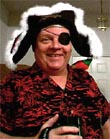|
|
This topic comprises 3 pages: 1 2 3
|
|
Author
|
Topic: PTR Rollers and Nitrate film
|
|
|
John Pytlak
Film God

Posts: 9987
From: Rochester, NY 14650-1922
Registered: Jan 2000
|
 posted 07-04-2007 11:23 AM
posted 07-04-2007 11:23 AM





Kodak did not specifically test PTR film cleaning with nitrate film, but I know they have been used successfully by film archives on nitrate. The Library of Congress uses film transfer devices built by Jeff Kreines, which uses PTR rollers for both cleaning and transport.
http://palimpsest.stanford.edu/byform/mailing-lists/amia-l/2006/09/msg00024.html
quote:
But what's most important is how the scanner handles film. There are no sprockets -- all the film touches are 3" PTR rollers (8 of them) and the raised edges of the curved teflon-coated gate. Tension can be adjusted so that minimal tension is used on fragile materials, or more tension on VS material that's curly (but the curved gate helps even more).
The prototype machine at the Library of Congress was designed for scanning paper prints, and has restored two Chaplin films (GENTLEMEN OF NERVE and DOUGH AND DYNAMITE), William S. Hart's first film (THE BARGAIN), and has also been used on some nitrate and safety material, including Mary Pickford's lost film LITTLE RED RIDING HOOD, which had, as Frank Wylie put it, the "consistency of a roll of packing tape." It showed last week at AMMI in NY.
When we delivered the prototype machine, someone had donated seven reels of rare WWI footage of the Battle of Liege. It was a nitrate print, in terrible shape. It would break when curved around a sprocket in an optical printer. There was little hope of preserving this film. Since it couldn't take the strain of a sprocket or small roller, the LOC hadn't repaired the perfs (required for printing) because it was likely a lost cause. (And hand repairs of shrunken film take a long time, using an x-acto knife and clear tape.)
So with nothing to lose, we threaded up a roll on the scanner, and hit the button. It scanned without incident, all seven reels. The large diameter PTRs, low tension capability, curved gate, and optical perf sensors all contributed.
| IP: Logged
|
|
|
|
|
|
|
|
|
|
|
|
|
|
|
|
|
|
|
|
|
|
|
|
|
|
|
|
|
|
All times are Central (GMT -6:00)
|
This topic comprises 3 pages: 1 2 3
|
Powered by Infopop Corporation
UBB.classicTM
6.3.1.2
The Film-Tech Forums are designed for various members related to the cinema industry to express their opinions, viewpoints and testimonials on various products, services and events based upon speculation, personal knowledge and factual information through use, therefore all views represented here allow no liability upon the publishers of this web site and the owners of said views assume no liability for any ill will resulting from these postings. The posts made here are for educational as well as entertainment purposes and as such anyone viewing this portion of the website must accept these views as statements of the author of that opinion
and agrees to release the authors from any and all liability.
|

 Home
Home
 Products
Products
 Store
Store
 Forum
Forum
 Warehouse
Warehouse
 Contact Us
Contact Us




 Printer-friendly view of this topic
Printer-friendly view of this topic









![[Smile]](smile.gif)
![[uhoh]](graemlins/uhoh.gif)





![[Big Grin]](biggrin.gif)



